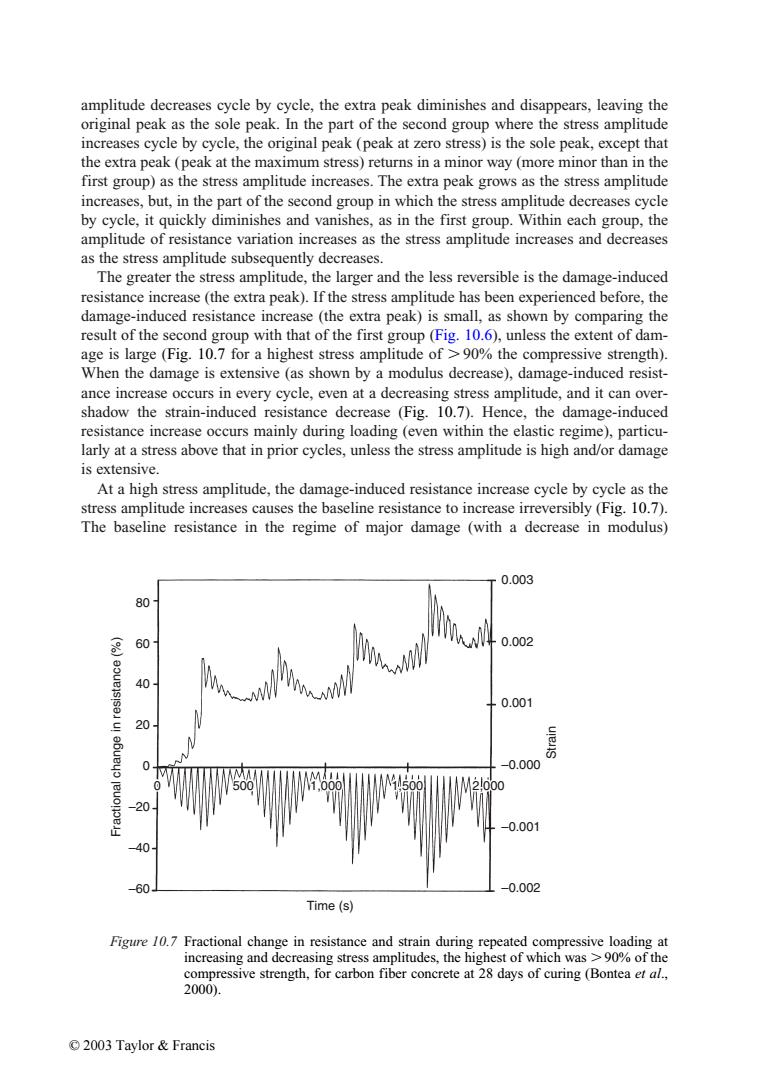正在加载图片...

amplitude decreases cycle by cycle,the extra peak diminishes and disappears,leaving the original peak as the sole peak.In the part of the second group where the stress amplitude increases cycle by cycle,the original peak (peak at zero stress)is the sole peak,except that the extra peak(peak at the maximum stress)returns in a minor way(more minor than in the first group)as the stress amplitude increases.The extra peak grows as the stress amplitude increases,but,in the part of the second group in which the stress amplitude decreases cycle by cycle,it quickly diminishes and vanishes,as in the first group.Within each group,the amplitude of resistance variation increases as the stress amplitude increases and decreases as the stress amplitude subsequently decreases. The greater the stress amplitude,the larger and the less reversible is the damage-induced resistance increase (the extra peak).If the stress amplitude has been experienced before,the damage-induced resistance increase (the extra peak)is small,as shown by comparing the result of the second group with that of the first group(Fig.10.6),unless the extent of dam- age is large(Fig.10.7 for a highest stress amplitude of >90%the compressive strength). When the damage is extensive (as shown by a modulus decrease),damage-induced resist- ance increase occurs in every cycle,even at a decreasing stress amplitude,and it can over- shadow the strain-induced resistance decrease (Fig.10.7).Hence,the damage-induced resistance increase occurs mainly during loading(even within the elastic regime),particu- larly at a stress above that in prior cycles,unless the stress amplitude is high and/or damage is extensive. At a high stress amplitude,the damage-induced resistance increase cycle by cycle as the stress amplitude increases causes the baseline resistance to increase irreversibly(Fig.10.7). The baseline resistance in the regime of major damage (with a decrease in modulus) 0.003 80 60 0.002 0.001 uens -0.000 20 0.001 40 60 -0.002 Time(s) Figure 10.7 Fractional change in resistance and strain during repeated compressive loading at increasing and decreasing stress amplitudes,the highest of which was >90%of the compressive strength,for carbon fiber concrete at 28 days of curing (Bontea et al., 2000). ©2003 Taylor&Francisamplitude decreases cycle by cycle, the extra peak diminishes and disappears, leaving the original peak as the sole peak. In the part of the second group where the stress amplitude increases cycle by cycle, the original peak (peak at zero stress) is the sole peak, except that the extra peak (peak at the maximum stress) returns in a minor way (more minor than in the first group) as the stress amplitude increases. The extra peak grows as the stress amplitude increases, but, in the part of the second group in which the stress amplitude decreases cycle by cycle, it quickly diminishes and vanishes, as in the first group. Within each group, the amplitude of resistance variation increases as the stress amplitude increases and decreases as the stress amplitude subsequently decreases. The greater the stress amplitude, the larger and the less reversible is the damage-induced resistance increase (the extra peak). If the stress amplitude has been experienced before, the damage-induced resistance increase (the extra peak) is small, as shown by comparing the result of the second group with that of the first group (Fig. 10.6), unless the extent of damage is large (Fig. 10.7 for a highest stress amplitude of
90% the compressive strength). When the damage is extensive (as shown by a modulus decrease), damage-induced resistance increase occurs in every cycle, even at a decreasing stress amplitude, and it can overshadow the strain-induced resistance decrease (Fig. 10.7). Hence, the damage-induced resistance increase occurs mainly during loading (even within the elastic regime), particularly at a stress above that in prior cycles, unless the stress amplitude is high and/or damage is extensive. At a high stress amplitude, the damage-induced resistance increase cycle by cycle as the stress amplitude increases causes the baseline resistance to increase irreversibly (Fig. 10.7). The baseline resistance in the regime of major damage (with a decrease in modulus) Fractional change in resistance (%) Strain Time (s) 80 60 20 40 0 –20 –40 –60 0 500 1,000 1,500 2,000 500 1,000 1,500 2,000 0.003 0.002 0.001 –0.000 –0.001 –0.002 Figure 10.7 Fractional change in resistance and strain during repeated compressive loading at increasing and decreasing stress amplitudes, the highest of which was
90% of the compressive strength, for carbon fiber concrete at 28 days of curing (Bontea et al., 2000). © 2003 Taylor & Francis